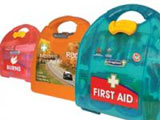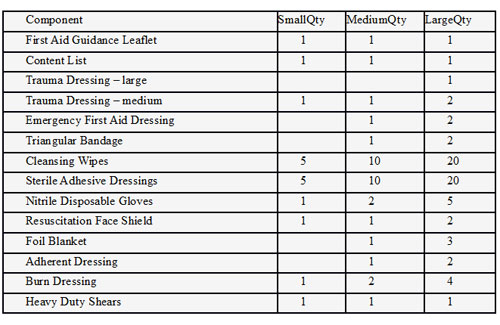 Until last month, no official standard or specifications existed for motor vehicle first aid kits in Britain. People would buy any good looking, portable first aid kit for vehicular use, or store some basic first aid items in a container that could be anything from a lunchbox to a toolbox or even shaving pouch. The British Standards Institution (BSI) has filled this gap in vehicular safety by introducing BS 85599-2, the new standard for motor vehicle first aid kits.
Until last month, no official standard or specifications existed for motor vehicle first aid kits in Britain. People would buy any good looking, portable first aid kit for vehicular use, or store some basic first aid items in a container that could be anything from a lunchbox to a toolbox or even shaving pouch. The British Standards Institution (BSI) has filled this gap in vehicular safety by introducing BS 85599-2, the new standard for motor vehicle first aid kits.
Car and vehicle first aid kit plays a vital role in case of accidents or medical emergencies. Items such as pressure bandages and splints can prevent injuries from worsening or even leading to mortalities. Yet, it is not always possible for an average person to envisage the kind of emergency he/she can potentially encounter when in a motor vehicle. Before BS 85599-2, the new standard for motor vehicle first aid kits in Britain, the selection of items for the car first aid kit depended upon some vague recommendations from the NIH or a few self-promoting articles by first-aid-kit sellers and manufacturers. Thankfully, that confusion is over, as BS 85599-2 clearly specifies the contents of cars and bigger vehicle first aid kits.
Contents of the Motor Vehicle First Aid Kit
The new first aid kits come in 3 sizes— Small, Medium and Large. The quantity of the first aid kits would depend upon the size of the vehicle and the number of people using it. Here are the recommended contents:

First Aid Kits for Cars, Vans, Minivans, Minibuses and Motor Bikes
Small first aid kits are suitable for motor vehicles with 1–3 passengers, such as motorcycles or coupes. Medium kits are recommended for vehicles with 1–8 passengers, such as cars, minivans, taxis, etc. Large kits are designed for 9–16 passengers, and are good for minibuses, vans etc. Vehicles with passenger capacities above 16 need to carry multiple first aid kits.
Other than the contents, the new UK standard also specifies the materials for the first aid kit containers, including locking and storing instructions. The first aid kits need to be clearly marked and visible for immediate use. The BSI standard also includes guidelines for motor vehicle categories and the recommendations on the type of first aid kit that is to be used for different types of vehicles.
BSI has developed the new standard in collaboration with several other organizations including British Healthcare Trades Association and Society of Motor Manufacturers and Traders. Britain now joins a number of other European countries where such standards exist. It is still not mandatory for motorists in Britain to carry first aid kits in the vehicles, but many of the new vehicle models now come equipped with first aid kits. Apart from providing guidance, the new standard will also build awareness about the importance of having first aid kits in motor vehicles and improve the safety in general.
While it is important to have first aid kits in motor vehicles, one should also be aware about how to use different items that these kits contain. If you are a workplace boss, running a demonstration or drill involving first aid kits wouldn’t be such a bad idea.
See The Workplace Depot's great range of First Aid Kits.
Posted in Expert Commentary